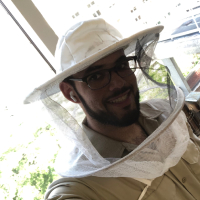
THE IDEA
Bees are known to tell time by light and social cues. Now, postdoctoral scholar in biological sciences Manuel Giannoni-Guzmán and researchers from Brandeis University, University of Puerto Rico Rio Piedras, University of Pittsburgh and East Tennessee State University have shown that the circadian clocks of bees can be altered by another surprising factor: temperature cycles inside the hive.

The researchers sought to better understand how bees lived in peripheral areas beyond where light enters the hive. They were surprised to find clear temperature fluctuations across the day throughout the hive, mimicking temperature oscillations caused by daylight.
To understand how important this temperature cycle was to a bee’s activity, the researchers put bees in constant and total darkness while exposing them to the temperature cycles they observed within the colony. Six days later, the scientists shifted the temperature cycle back by six hours. “We saw that the bees shifted their activity with the temperature, meaning their daily routines were responsive to temperature,” Giannoni-Guzmán said.
WHY IT MATTERS
The discovery that bees can tell accurate time from temperature cycles inside the hive shows that on a cloudy day or when bees aren’t going outdoors, they have other means to tell time accurately. This will affect the way that researchers understand, interpret and integrate what they know of bee behavior.
More broadly, as more extreme weather events occur around the world, bees will face challenges to maintaining the activities that keep them and the agriculture they support healthy and vibrant. If part of the southern U.S. is hit with an unexpected snowstorm, bees getting ready to forage might not realize they need to conserve energy and heat the hive. In the event of a 100-degree day, bees will have to expend a lot of energy keeping the colony cool. It is those considerations that will influence colony health or possible colony collapse, Giannoni-Guzmán said.
WHAT’S NEXT
“We want to see how important this research is come winter in Tennessee, when bees aren’t leaving the hive as much,” Giannoni-Guzmán said. “We will be interested to see how our findings apply to temperate regions where there is a greater degree of temperature variability across the year.” This research will also reshape how researchers think about bees’ circadian rhythms.
FUNDING
This work was sponsored by the National Science Foundation awards 1026560, 1633184, 1707355 and the National Institute of Health grants 2R25GM061151-13 and P20GM103475.
GO DEEPER
The article, “The Role of Colony Temperature in the Entrainment of Circadian Rhythms of Honey Bee Foragers,” was published in the journal Annals of the Entomological Society of America on May 26.